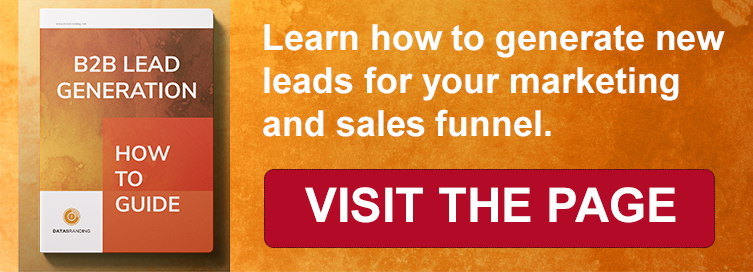 In my career experience of more than 25 years, I have found three approaches to attract potential customers to your sales funnel. Of course, the strategy, tactics, and budget will change depending on which method you choose. Discover what direction your company needs and which one makes the more sense to you:
In my career experience of more than 25 years, I have found three approaches to attract potential customers to your sales funnel. Of course, the strategy, tactics, and budget will change depending on which method you choose. Discover what direction your company needs and which one makes the more sense to you:
To grow your company, you need to generate new leads. There are a lot of tactics to do that. From sales and advertising to marketing and public relations. I wanted to simplify the principles of the three main approaches:
- Prospecting
- Reach
- Attract
1 Prospecting
Prospecting is the oldest approach. It started with canvassing or knocking dor to dor in a neighborhood and hoping to find someone who needs your solution. As the population grew and the products and services became more complex, the need for segmentation became evident.
Segmentation is based on the common characteristics of your target group. So, it started with demographic, psychographic, geographic, and behavioral segmentation lists.
The need to reach a large and geographically disperse group developed tactics like direct mailing and cold phone calls. With technology, they evolve to massive email campaigns.
Modern approach
The modern approach is called Account-Based Marketing. This is a strategy based on targeting companies in a specific niche. The focus is set on the most significant opportunities. The goal is to create personalized buying experiences for a set of high-value accounts. First, you need to understand the needs of a big company and then start nurturing the executives that need your solution. This way, you will attract not just one executive but a set of company teams.
Advantages of prospecting:
It is easy to calculate the return on the investment when you have the conversion rates and the costs of the media used to contact the potential customers.
It might not be so expensive. However, many companies hire sales reps that will only charge a commission if they succeed, so you need to provide the lists and the technology to help them reach the leads, like in a call center.
Disadvantages of prospecting:
The main disadvantage of this approach is that the potential client might not be active for sale. In other words, they don't need your solution right away. Or maybe they will never need it. So it is mainly based on hope.
This approach has a shallow success rate. It would help if you visited many houses, made a lot of calls, and sent lots of emails. Then, the success rate might be below 1%.
Sometimes it can be invasive, like cold calls and emails. These will make you become SPAM. You need to generate some value to avoid becoming a spammer. This could be providing free helpful information, education, or entertainment.
The sales and marketing teams need an excellent resistance to frustration.
2 Reach
In this approach, you are trying to reach a big group of people through mass media channels. The principle is simple:
- Design a creative message that will explain your solution.
- Repeat the message many times.
- Use as many channels as you can afford.
Repetition will generate familiarity, and familiarity is going to become trust. And we like to do business with brands we trust. But, with repetition, you will be at the top of your audience's mind, so when a potential customer requires the solution you provide, he will remember that you can give the solution and take the next step.
This is the principle of advertising. Your message will reach everyone who might need your solution.
Modern approach
We all have been exposed to traditional advertising messages on radio, TV, newspapers, magazines, and billboards. The same techniques are being used in paid social media in digital marketing. The only advantage is a deeper segmentation based on consumer tastes and preferences.
Another technique is sending people to websites and measuring the impact of a specific mass media. For example, you make a QR code or a particular link to measure for that media or ad in print advertising. In TV or radio, you make a call to action with a URL so people can connect immediately to your website; you can measure the specific URL or correlate the visits in the schedule of the ad.
Advantages of reach:
It's great for awareness of your brand. You can make tons of people aware of your brand, solution, and company. As an example, think of Coca-Cola. They have been doing advertising for a long time, without interruptions and in all the mass media channels they can. As a result, almost everyone on the planet knows the brand, the product, and the solution.
You can measure and have quick results. The timing of a campaign and the impact strongly correlate with the results. These results are short-term. These campaigns are outstanding when you have stationery products that need quick campaigns.
Reach to large amounts of people. You can reach a big audience in a short period.
Disadvantages of reach:
Unfortunately, this approach is very invasive. Imagine that you are consuming the content you are interested in at this time. Then, suddenly that content is interrupted with a message you are not interested in from a brand you don't know, and they generate no value for you, or at the most, give you a little bit of entertainment with a funny and creative ad. Nowadays, we call this SPAM.
Expensive and unreachable for many small or medium businesses. Because mass media costs are enormous, they have to charge expensive fees to the advertisers.
Because you are reaching a broad audience, not everyone who receives your message will be your actual customers; this is called spillover. Imagine the product of feminine pads, the male audience will never be a customer, but you paid so they can also receive your message and be aware of your product. Ask a male if they know a brand, and you will see they know at least three brands.
Not all of your audience will be active for the purchase. That means they are not ready or in need of your solution right away.
3 Attraction
Internet search changed everything. If you need to solve an issue, you first go to Google it or use the search engine of your choice. This is revolutionary. You can attract people who are active and searching for a solution, and they might be willing to pay to solve that problem.
When you ask a search engine a question, they will give you two types of answers. The ones that say advertising and those that don't say anything but the information you are looking for.Paid search results
The first results you see if there is an advertiser are the results with a small banner that says advertising. Only 3% of the people click on these results because they intend to learn how to solve a problem, not buy a solution.
Advertisers use search engine results when a person types a keyword they consider is related to their solution. For example, if someone searches for "Best running shoes for marathons" and your brand produces this kind of product, you will buy and auction for the word running shoes. Every time someone clicks on your ad, you will pay Google or the search engine for that traffic link.
Organic search results
Organic search is the ten results the search engine recommends that answer your question. 97% of the searches click on these results. How do you position your brand in these results? With content marketing. We have a great article that explains it more in-depth, "How does Google work for demand generation", we recommend you to read it.
If you give a great answer, you have a lot of answers on your website around that topic, and you have a quick and secure website, the search engine will send you tons of visitors looking for the solution you provide.
Mix of techniques
There is a technique that mixes attract and reach called Remarketing. Do you ever have the feeling that someone is stalking you? For example, you talked about traveling to Hawaii or entering a website discussing what to do in Hawaii. As a result, all the websites or social media you visit are full of Hawaii advertising. Well, that is remarketing. Search engines can track your searches and then advertise content that can be useful. NOTE: You can turn off these settings in your browser and control retargeting. Ask Google, depending on your web browser.
Advantages of attracting:
The most important is that people detect an issue they need to solve. Then, they are active and searching for your solution. Anyone can make a great content marketing strategy.
It does not matter the size of the organization. It is cheaper than traditional advertising. You don't have spillover; every cent you invest in this approach goes to your actual target.
Disadvantages of attraction:
For organic search results, the disadvantage is that you need lots of content in the shape of blogs, articles, videos, podcasts, and website pages. The amount of content your website has is essential in the search engine algorithm. Therefore, only websites constantly making new content and having lots of articles are vital to the search engines.
Building all this content takes time. It is a medium and long-term strategy. Gaining the trust of the search engines also takes time.
For paid search engine results, the disadvantage is that you are bidding against other advertisers willing to raise the keywords' bid every time. This means that your budget will increase every time competitors do the same. So, every time you will pay more for the same results. The second disadvantage is that you are investing in only 3% of the visitors that made the same question.
For remarketing, the disadvantage is that it is very invasive, and people don't like to be harassed.
Which approach fits your business?
The truth is that there is no correct answer. A good strategy involves the three approaches playing at the same time. Unfortunately, not every company has the budget to do so. If your resources are not unlimited and you need to spend money wisely, which one makes more sense for your company?
Please leave your thoughts, and let's start a conversation about your actual situation.
If you want to learn more please subscribe to our blog or visit:

